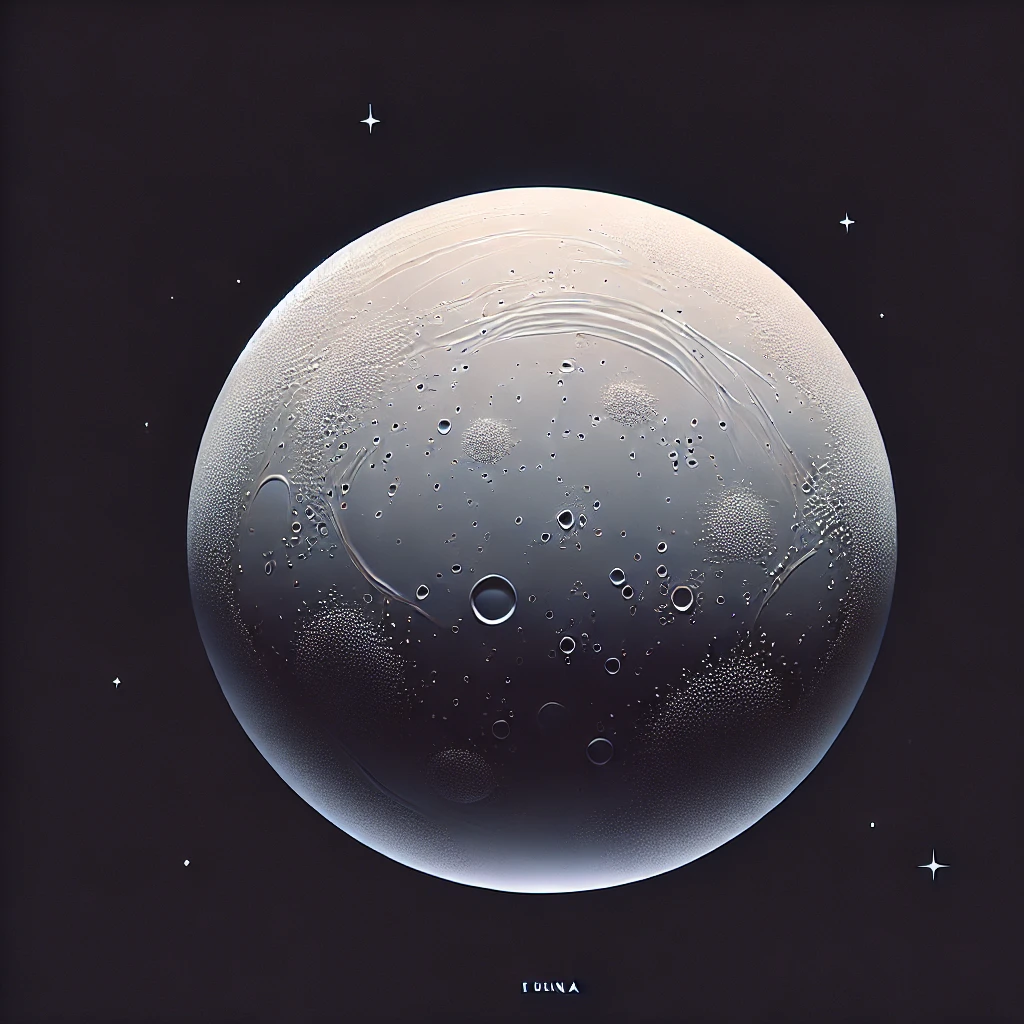Lumina is a crystalline moon orbiting the gas giant Zephyros in the Upala System of the Solarae Galaxy. Known for its unique crystalline composition, bioluminescent ecosystems, and complex biomes, Lumina serves as the homeworld of the Luminar species. The moon's surface is characterized by vast fields of light-refracting crystals, prismatic mountain ranges, and luminescent bodies of semi-liquid crystal.
Physical Characteristics
Astronomical Data
| Parameter | Value | Notes |
|---|
| Type | Crystalline moon | Unique in Upala System |
| Orbital Period | 20.5 Lumina days | Tidally locked to Zephyros |
| Radius | 3,120 km | |
| Surface Gravity | 0.8 g | |
| Surface Area | 122 million km² | 30% crystal seas |
| Mass | 4.2 × 10²² kg | |
| Density | 5.2 g/cm³ | |
| Average Temperature | 20°C (68°F) | Maintained through tidal heating |
Composition
- Core: Dense metallic compounds with high crystal content
- Mantle: Silicate minerals interwoven with crystal matrices
- Crust: Complex crystalline formations with varying densities
- Surface: Natural crystal growths, prismatic formations, and semi-liquid crystal seas
Geographic Features
Major Regions
The Crystal Peaks
- Location: Northern hemisphere
- Height: 12-15 km average
- Area: 2.3 million km²
- Notable Features:
- Natural quantum resonance chambers
- Prismatic crystal spires
- Bioluminescent cavern systems
- Endemic crystal-based life forms
The Luminous Plains
- Location: Equatorial belt
- Area: ~500,000 km²
- Characteristics:
- Light-refracting crystal fields
- Shallow crystal pools
- Geometric crystal formations
- Photosynthetic crystal gardens
The Opalescent Seas
- Total Area: 36.6 million km²
- Composition: Semi-liquid crystalline material
- Properties:
- Variable viscosity
- Bioluminescent properties
- Tidal interactions with Zephyros
- Unique aquatic ecosystems
Natural Barriers
The Prismatic Mountains
- Physical Properties:
- Height: 12-15 km
- Length: 8,000 km circumferential chain
- Composition: Dense quantum crystals
- Notable Features:
- Natural quantum interference fields
- Crystalline waterfalls
- Geometric cave systems
- Unique mineral deposits
The Void Chasms
- Dimensions:
- Depth: Up to 20 km
- Width: 2-5 km
- Total Length: 12,000 km
- Characteristics:
- Light-absorbing crystal formations
- Gravitational anomalies
- Underground rivers of liquid crystal
- Specialized cave ecosystems
Biomes and Ecosystems
Primary Biomes
Crystal Forests
Luminous Wetlands
Quantum Valleys
Prismatic Tundra
Crystal Deserts
Atmospheric Composition and Dynamics
Atmospheric Layers
| Layer | Height (km) | Primary Components | Notable Features |
|---|
| Crystallosphere | 0-10 | N₂, O₂, Si vapor | Crystal formation zone |
| Luminosphere | 10-50 | N₂, rare gases | Light phenomena |
| Quantosphere | 50-100 | Ionized particles | Energy patterns |
| Outer Shell | 100+ | Trace elements | Aurora displays |
Weather Phenomena
Crystal Storms
Light Cascades
Quantum Weather
Natural Resources
Crystal Deposits
| Type | Location | Properties | Uses |
|---|
| Pure Growth Crystals | Crystal Peaks | Self-replicating | Construction |
| Energy Crystals | Thermal Vents | Power storage | Energy generation |
| Quantum Crystals | Deep Mines | Reality manipulation | Advanced technology |
| Luminous Crystals | Coastal Regions | Light emission | Illumination |
Energy Sources
Geothermal
Solar
Quantum
Notable Geographic Locations
Natural Wonders
The Grand Prismatic Spire
The Luminous Abyss
The Quantum Nexus
Geological Features
Crystal Fault Lines
Thermal Regions
Climate Patterns
Regional Variations
| Region | Average Temperature | Precipitation | Notable Features |
|---|
| Polar Caps | -50°C to -30°C | Crystal snow | Permanent ice crystals |
| Temperate Zones | 10°C to 25°C | Light rains | Moderate growth |
| Equatorial Belt | 20°C to 35°C | Energy storms | Rapid crystal formation |
Seasonal Changes
Light Season
Dark Season
Geological Activity
Crystal Tectonics
Growth Patterns
Fault Systems
Volcanic Activity
Crystal Volcanoes
Thermal Features
See Also
References
- Crystallos, K. (30,245 AD). "Lumina: A Geological Marvel"
- Quantum, J. (30,100 AD). "Crystal Tectonics of Lumina"
- Prisma, L. (30,350 AD). "Biomes of the Crystal Moon"
- Aurora, T. (30,400 AD). "Atmospheric Dynamics of Lumina"
- Geologic Institute of Lumina (30,500 AD). "Comprehensive Geological Survey"



Comments